-
Posts
319 -
Joined
-
Last visited
-
Days Won
14
Content Type
Profiles
Forums
Blogs
Gallery
Events
Store
Posts posted by TracA
-
-
Dear No One,
Thank you, as always, for the correction and edification. I will need to redo my documentation, especially the translation of the second page of the Award Document.
Thank you again!
Tracy
0 -
Greetings,
I have obtained another boxed Military Bereaved Family Badge, but this one came with two Yasukuni Shrine Enshrinement Badges. In addition, I have the Bereaved Family Badge award document as well as the Yasukuni Enshrinement ceremony invitation and the envelope in which it came. The number on the enshrinement badges matches the number on the invitation envelope. All of the items were neatly and carefully packed into an Imperial Gift Foundation Imperial Soldier’s Relief Association lacquered box.
I will add posts in stages, as I work through the award document, invitation, and envelope. As my guide I have used the old Dai Nippon KIA Badges webpage via the Wayback Machine (referenced above) as well as Michael J. Martin’s book entitled Japanese Military and Civilian Award Documents 1868 - 1945 (Atglen, PA: Schiffer Publishing Ltd., 2016). The seller of the items also contributed, but I always try my best to use the wonders of the Internet in order to verify and hopefully add the kanji to my cataloging write-up.
It really is fascinating to have all of these “pieces” together and ostensibly for the same deceased individual and his mother.
I hope that you enjoy and as always, please add your corrections and additions.
Tracy
Obverse of this particular Military Bereaved Family Badge, a simple yet aesthetically pleasing design:
The reverse, plain with the exception of the name of the badge:
The award document for the badge.
This is the cover, and the central column is 軍人遺族記章授與證書 for “Military Bereaved Family Badge Certificate of Conferment/Record of Issue”. 第號, for “number”, are printed on the cover but the number itself is handwritten in blue ink. I believe that it is 参七三二六 for “37326”; or perhaps it could be “37226”, as the long horizontal line between the two sets of two shorter lines could possibly be a way of separating 二 and 二. I am purely speculating here. I note that 参 is document kanji for 3.
This is the first page on the inside of the cover.
The first column on the right is as above. The next column is “deceased/late” and the branch of service in printed, black kanji. Here it is 故陸軍 for “deceased/late army” and in handwritten blue ink is what I believe to be 伍長河原末吉毋 for “Corporal Kawahara Suekichi, mother” and the next column in handwritten blue ink is what I believe to be 河原タルヱ for “Kawahara Taruwe”. Altogether the three columns could be read as “Military Bereaved Family Badge record of issue for deceased army corporal Kawahara Suekichi, to his mother Kawahara Taruwe”.
The next two columns are translated by Martin as “A bereaved family badge is conferred to the person stated to the right in accordance with the Soldiers’ Bereaved Family Badge ordinance” (Martin, p. 161).
The sixth column begins with the date. Of course the kanji for the era (Showa), year, month, and day are printed in black with the actual numbers handwritten in black ink. We have 昭和十六年七月一日 for “Showa 16 [1941] July 1st”. The old Dai Nippon KIA Badges webpage notes that this is the date that the badge was issued and not the servicemember’s date of death. After the date is 陸軍省 for “Ministry of the Army” and the red seal is, I would believe, the seal of the Army Ministry.
This is the second page.
According to the old Dai Nippon KIA Badges webpage it is rarely filled out. It has a title and then four columns. All translations are taken from this webpage. The title is 軍人遺族記章繼承之證 for “Military Bereaved Family Badge, record of [the] departed” and the four columns are (from top to bottom): “Date of Death”; “Name and Rank of Departed”; “Stamp of City/Town/Village Headmaster”; “Cause of Death”.
-
Question: it appears as if 繼承 is translated as “departed” or “deceased” but I cannot for
the life of me verify that. What am I missing here?
The back page of the award document.
This describes the order of precedence for which family member receives the Military Bereaved Family Badge. Per the old Dai Nippon KIA Badges webpage the order is “...widow, children, father, mother, grandfather, grandmother, etc.” Obviously there would be an order of precedence among the surviving children. You may also wish to consult Murphy, Paul L. and Steven L. Ackley. In the Name of a Living God…, p. 1.
1 -
-
Wonderful collection. Thanks for sharing.
Tracy
0 -
No One,
As always, thank you for the clarifications.
All the best,
Tracy
0 -
Greetings,
I have finally obtained a boxed KIA Badge, more literally translated as a Military Bereaved Family Badge. My badge came with a single Yasukuni Shrine Soldier Enshrinement Badge with ribbon. I have no idea if the Enshrinement Badge, for attendance in the applicable ceremony, was given to the family member who was the actual recipient of the KIA Badge that I have obtained, or if the two were separate and simply combined at some point in the past. I would assume that the latter is more likely.
A brief description of who qualified for the badge, how it was obtained, who the approving authority was, and who presented it can be found in Murphy and Ackley’s In the Name of a Living God. The non-government badges and medals of Imperial Japan, including Police, Fire Brigade, Red Cross, Veteran, and Patriotic Groups. (San Ramon, CA: Falcon Books, 2005). You may also wish to consult Rich Catalano’s old Dai Nippon website archived via the Wayback Machine, found at https://web.archive.org/web/20200204141015/http://www.imperialjapanmedalsandbadges.com/kia.html and https://web.archive.org/web/20200225125252/http://imperialjapanmedalsandbadges.com/yasukuni.html. The old Dai Nippon website notes “The Yasukuni badge was not given as an award. It was given to the bereaved family members at the enshrinement ceremonies and served as an ID just for the events. These ceremonies were held twice a year (spring and autumn).”I’m going to appropriate the brief description of the KIA Badge, with additions, from Murphy and Ackley: the medal is a dark silver color, approximately 25.4mm in diameter, and in the shape of a cherry blossom. The obverse is a stylized cherry blossom with a pebbled background and it is superimposed on a plain cherry blossom shape, with the ends of each offset. The reverse of the badge is plain except for the name of the badge, written in a row of two kanji with the remaining four kanji in a column below the center. The badge is attached to a tasseled purple cord tied in a bow, the length of which from the top of the cord to the ends of the tassels is between 76.2mm and 101.6mm. The top of the tassel loops through a ring that is attached to a safety pin assembly. The wooden box is approximately 120.65mm long by 63.5mm wide, the lid of which has the name of the badge in gilt kanji. The interior of the box is a yellow velour at the top of which protrudes a small brass hook. Since the medalbed is not fitted, the badge's safety pin “rests” on the brass hook and this is what holds the badge in place inside the box.
Regarding the Yasukuni Shrine Soldier Enshrinement Badge with ribbon, not mentioned in Murphy and Ackley, that I have in my possession: the bright silvery badge is thin and of light weight. Made of aluminum? It is approximately 25mm wide. The obverse reproduces the stylized cherry blossom of the KIA badge (minus the pebbled background and one shape superimposed on another) and the reverse is plain except for the month and year of the particular enshrinement ceremony for which the badge is applicable. I note that on my example and the examples on the old Dai Nippon website the kanji for the year and month are either (1) in two (or three) rows on the bottom of the badge with regnal year and month from right to left or (2) in two columns roughly down the center of the badge with regnal year in the right column and the month in the left column. There may be other configurations. The badge is affixed to a colored ribbon stitched to a thin, coarse looking white cloth with stitching around its perimeter. On my example the ribbon consists of a central 14mm white stripe with a 3mm blue stripe running down the center. On either side of the white stripe are 11mm copper brown stripes each with a 3mm blue stripe down the center. Total width and length of my example is 35mm x 70mm. On the top of the white cloth on my example is the regnal year from right to left followed by the season corresponding to the particular enshrinement ceremony for which the badge is applicable. On the old Dai Nippon website there are examples with the kanji from left to right. Below the kanji, on my example, is the number 1 in bold red and below that is the number 83 in bold black. All but two examples (a third possible example is unclear) on the old Dai Nippon website conform to this pattern, albeit with different numbers. The two “counterexamples" are attributed on the website to either “an earlier version or perhaps very late war” or the year 1944.
On the old Dai Nippon website, where they are dated to pre-1940, are examples of the badge in gilt with a rising sun emblem in the center. However, not all pre-1940 badges have such a design. There is also an example of a ribbon without the date on the white cloth. Generally the ribbon color pattern is specific to the ceremony for that year and season/month, and is changed for the following ceremony, which is changed again for the next ceremony, etc., etc. However, on the War Relics Forum thread (see below) it was noted that the 1940 badges for both ceremonies had the same color ribbon in, what I assume to be, the same pattern.
What is the meaning of the color pattern on the ribbon and the numbers in red and black? Using the only three sources that I could currently find, the old Dai Nippon websites (referenced above) and a 2020 thread from the War Relics Forum (https://www.warrelics.eu/forum/japanese-militaria/yasukuni-badges-776793/), does not result in a consensus explanation.
- The red and black numbers are either (1) a key to finding the deceased’s name and hometown in the Yasukuni Shrine record books or (2) seating/group arrangements for the ceremony and/or perhaps the festivities afterwards.
- The ribbon color pattern functions as (1) a signification of seating arrangements or (2) color coding for crowd control or (3) a color coded security system used to identify who was permitted at a particular ceremony or (4) perhaps a combination of these functions.
I would like to point out that on the old Dai Nippon Yasukuni Enshrinement Badge page either a single badge and ribbon is depicted or two badges and ribbons with matching red and black numbers are depicted. There are no pictures of three or more badges and ribbons with matching red and black numbers. Evidence that the ceremonies were limited to two attending family members?
Any and all correcting or corroborating information, as well as additional information, is welcome. If you have it, then please consider replying.
I find the Military Bereaved Family Badge appealing in its relative simplicity, and I find the enshrinement badge fascinating in its practicality.
All the best,
Tracy
Obverse of the Military Bereaved Family Badge:
Reverse, with the inscription 人軍遺族記章 for Military Bereaved Family Badge:
Box lid with the badge name in gilt kanji:
Box bed with the protruding brass hook:
Yasukuni Shrine Soldier Enshrinement Badge with ribbon obverse. The kanji are 秋年四十和昭 for Showa 14 (1939), Autumn.
Badge reverse with 十月年四十和昭 for Showa 14 (1939), October.
1 -
Hi Nick,
It is the same breast star and I took the photo; the photo was not taken by the seller.
This situation is most bizarre. In the photo we can see an outline of the M but under 25x magnification I cannot find even the hint of an outline when examining the star.
A mystery of sorts.
All the best,
Tracy
0 -
11 hours ago, JapanX said:
Of course it has M mark

Most likely case was manufactured before 1938 https://asiamedals.info/threads/silver-kanji-vs-gold-kanji-lettering-on-the-lids-of-the-japanese-order-cases.26112/
But such set could be awarded 1938/1939/1940.
Yes, indeed.
Best,
Nick
Nick,
Thank you, as always, for the information.
That M on the breast star us pretty freaky. I've just spent about 15 minutes examining the star with a 25x magnifying glass from all different angles and I cannot for the life of me see the M or even a faint outline of an M. Nonetheless, when I look at your repost of my photo, and when I enlarge my original photo, there the M clearly is. Very strange indeed.
Thanks.
Tracy
1 hour ago, No one said:No One,
As always, thank you for the kanji lesson. This is an important part of my learning and my documentation.
Thanks.
Tracy
0 -
I was finally able to add this magnificent Order of the Sacred Treasure Grand Cordon to my collection. The badge has the M mint mark of the Osaka mint, thereby dating this badge from 1930 to 1943. See Medals of Asia at https://asiamedals.info/threads/mark-m-on-japanese-orders-and-medals-who-and-when.14818/. Part of me expected to also find an M mint mark on the breast star, but the star has no marks whatsoever. Note that the lacquered case has a gold border on the lid, which if I am not mistaken puts it at least in the same or similar “age group” as the badge.
Two Questions:
- If the badge has an M mint mark is it common that the breast star not have one? Part of me expected that if the “set” were manufactured at the Japan Mint, then both the badge and breast star would have the M mark if one of them had the M mark. However, I have no evidence upon which to base my expectation.
- Are there any known time coordinates for cases with the gold border, or a border at all? I know that the Medals of Asia website has a picture of a Grand Cordon case from 1943 with silver kanji and silver border.
It truly is a beautiful set. As usual, my cell phone camera and poor lighting set-up wreak havoc on the colors.
Tracy
In the case:
Badge obverse:
Badge reverse:
M mint mark up close:
Breast star obverse:
Breast star reverse:
The sash. I’m not sure what the official color is, but it looks powder blue to me.
The rosette is the same color as the sash:
Case lid:
Finally, a close-up of the case clasp:
1 -
On 01/09/2023 at 20:18, hxihiu111 said:
Perhaps the name of manufacturer.
At first that's what I thought, but when I couldn't find reference to that manufacturer at Medals of Asia (https://asiamedals.info/#japan.459) and after No One helped me translate the kanji, I then figured that the stamp was that of the certifying official.
Tracy
On 01/09/2023 at 22:15, No one said:Dear TracA,
" Regarding the red stamped surname Iwaki, I assume that is the surname of the official (?) who actually certified that this was medal No. 4261. "
Yes, I think so. This seal is the equivalent of a signature and makes the text official.
As for the last kanji "𭈹" it is more often/commonly written "號".
Yours sincerely,
No one
No One,
You read my mind. I was having much difficulty transcribing that last kanji as I could only find it as two separate characters and not a single character.
Thank you, as always.
Tracy
0 -
Dear No One,
Thank you so much for your assistance. Although I was able to figure out that 貮 and 拾 are document kanji for numbers, I failed to realize, among other things, that 壱 is also.
Regarding the red stamped surname Iwaki, I assume that is the surname of the official (?) who actually certified that this was medal No. 4261.
Thank you again.
All the best,
Tracy
0 -
Greetings,
I thought that I would add to this wonderful and informative post started by No One and contributed to by JapanX.
Below is my recently obtained 1900 War Medal/Boxer Rebellion Medal. To me what makes this example special is the handwritten kanji and clearly what appears to be a stamped red circle with two kanji inside, all on the underside of the lid. As usual I struggle with the kanji transcription and interpretation. So, I’ll have questions to go along with the picture of the underside of the lid.
Thank you.
Tracy
Obverse:
Reverse:
Box lid with the gilt inscription 明治三十三年従軍記章 for “Meiji Year 33 War Medal”. 1900 was the 33rd year of Meiji:
Underside of the lid. The right column is 従軍記章え?番号. I cannot figure out what the sixth kanji is or what it and the fifth could mean together. I believe that the other kanji translate to “War medal…number”.
The left column is 第四十貮百六拾?師. I believe that the first eight kanji translate to “Number 4260”. I cannot figure out what the eighth kanji is but I have an inkling that it and the ninth kanji might be a surname. Perhaps 若師, Wakashi?
Close-up of the two kanji inside a circle, all stamped in red: I believe that the first kanji is 岩 and the second kanji is possibly, maybe 岸 for a combined 岩岸, meaning Iwakishi? Could this be a manufacturer’s stamp? Maybe a place name, perhaps the city of Iwaki in Fukushima prefecture, a place where the recipient was issued the medal?
0 -
Wait, I'm confused. Doesn't the "R" on the reverse stand for "Real"?
Tracy
0 -
No One,
Thank you very much for the information, pictures, and links. It is greatly appreciated.
All the best,
Tracy
0 -
Another WPA badge has come into my possession. This is a Special Member Badge. I’ve posted one previously in this thread, but this new one is a bit different.
This one has a red cord attached between the badge and the suspension bar.
The pin on the reverse of the suspension bar is different from the one on the Special Member Badge posted above. The pin on the reverse of this suspension bar is of one piece such that the left end is in the form of a hook and the right end is bent in the shape of two circles such that the rest of the pin comes across and can be placed under the hook. On the reverse of the suspension bar is a small diameter tube attached to the middle second and third part of the bar and through which the pin is “threaded”. Therefore the inscription on the reverse of the suspension bar has 掛ー to the left of the pin tube and 襟半 to the right of the pin tube. 掛ー襟半 for "hanging collar half". For hanging on the kimono half-collar. Thank you JapanX for that bit of information.
Instead of a wooden box this badge came in a red cardboard box with a blue cardboard insert to hold the badge. The red color is a paper that is affixed to the lid and its sides as well as the bottom sides. It does not fully cover the inside of the lid or the bottom of the box. The badge name is on the cover of the box in gilt: 別特会員章 for “Special Member Badge”.
Tracy
Obverse:
Reverse:
Cardboard box lid:
2 -
On 20/08/2023 at 19:36, No one said:
Dear TracA,
Thank you, it a pleasure to share knowledge.
Here is another medal on this subject, and it's both attractive and well-crafted.
The purpose of the event was to commemorate the ceremonies that were held at Ueno Park, where the people could acclaim the new emperor Taishō.On this medal one can see two other banners shown above.
Here is a postcard of the entrance:
都市・東京の記憶_御大禮記念國産振興東京博覽會繪葉書_上野公園入口誘導塔 (tokyo.lg.jp)
Yours sincerely,
No one
No One,
Another beautiful medal, and a different two banners on a medal again struck in honor of the Taisho enthronement.
I assume that the five banners and staffs referenced in your post above were not specific to the Emperor Taisho, but I do assume that the were specific to, and used only for, the Emperor. Is my assumption correct? Where might I go to learn more about the history and use of the five banners/staffs?
Thank you as always.
Tracy
0 -
No One,
What a wonderful specimen.
All the best,
Tracy
0 -
I haven’t posted in this thread for a while, but I recently came to possess another WPA Special Supporter Member badge. When looking through the wonderful Medals of Asia page on the different variants of this badge (see https://asiamedals.info/threads/special-supporter-member-badge-of-womens-patriotic-association.25981/) it appears as if mine could be a type of hybrid. To me there is no doubt that the obverse (looking at the stems and leaves on the bottom) is classified as the 4th variation. However, the pin construction on the reverse matches that of the 2nd, 3rd, and 5th variants.
A hybrid?
Tracy
Obverse:
Reverse:
1 -
14 hours ago, No one said:
Dear TracyA,
As for the staffs, as there are five banners (旛 / ban) there are five staff, one staff specific for each banner:
・霊鵄形大錦旛 / Reishi Keidai Kinban = A golden kite that saved Emperor Jimmu with a flash of light.
・月像纛旛 / Gesshō Tōban = moon embroidered on white brocade
・萬歳旛 / Banzai ban = 5 sweetfish, Itsuhe, and the word “banzai”
・日像纛旛 / Nisshō Tōban = The sun embroidered on red brocade.
・頭八咫烏形大錦旛 / Yatagarasu Daikinban = The Yatagarasu that guided Emperor Jinmu to Kashihara in Yamato.
Yours sincerly,
No one
Dear No One,
Thank you so much for the information on the fish, jug, staffs, and banners. Your generosity with your knowledge has added greatly to my documentation and knowledge.
All the best,
Tracy
0 -
15 hours ago, Farkas said:
Hello both,a great description of a lively medal, 👍
it made me find mine, the swivel bar is a bit bent and the ribbon is a bit torn…. but that’s the way I like them 😊
If I may, here’s a couple of pictures
I’d never thought about it’s originality 🤷♂️ (to me) it has great detail, then I saw the fish on yours! Yours have crystal clear tails and my fish have no tails at all!Pictures may not show it but they are very blobby, I hope you’ll tell me it’s just wear but either way, compared to the the first ones detail? it was lovely seeing it like that.
best wishes
tony 🍻
ps
I don’t know their history together before me, but they came from Japan together and live together now so seemed rude to leave his friend out.
Hi Farkas,
Yours is a wonderful example. I also collect ancient Greek coins of the Thessalian city of Larissa and the condition of your medal reminds me of a numismatic phrase which I believe is applicable here: “honest wear”.
Sadly I have no experience with detecting fakes but since this medal is, I believe, quite common, I would assume that there wouldn’t be much profit in producing fakes. I chalk up the “blobbiness” of the fish on your medal to worn dies.
Always nice to keep together medals and such that you acquire together.
All the best,
Tracy
1 -
No One,
Thank you for the post! What a great medal, especially since it wholly reproduces the banners from the obverse of the Taisho Enthronement Commemorative Medal. Also, very interesting poem.
All the best,
Tracy
2 -
I just picked-up an Order of the Sacred Treasure 7th Class with the mintmark M. Known time coordinates for this mark of the Japanese mint are March 1930 to April 1943. See Medals of Asia at https://asiamedals.info/threads/mark-m-on-japanese-orders-and-medals-who-and-when.14818/.
I’m pretty sure that my decoration, case, and button rosette are a “Frankenstein”. The color of the rosette is a pale light blue while the ribbon color is a grayish white. The real clincher is the fact that the case does not have a clasp; it is spring loaded. The case also does not appear to be made of wood. It feels like plastic (bakelite?) and when I let it snap shut it sounds like plastic instead of wood. I believe that such cases were certainly not produced during the 1930s to the early 1940s. I note that the beveled edge on the lid of this case is much higher than all of the other cases with clasps that I own.
Question: any known time coordinates for spring loaded cases?
Nonetheless, the decoration is very pleasing to the eye, with a nice patina and with the gilt color inside the seal script kanji on the reverse intact.
Enjoy.
Tracy
Obverse with button rosette:
Reverse. My cell phone camera and the lighting fail to reveal the beautiful patina. In the photo below it just looks dark:
Close up of the M mintmark:
The case lid. Note the absence of a clasp on the bottom edge of the case:
0 -
Here we have a Taisho Enthronement Commemorative Medal. I believe that this medal is somewhat or fairly common. The simple description, per Peterson 3rd edition p. 56 and Rich Catalano’s The Imperial Ordinances for War and Commemorative Medals of Japan and Manchukuo (4th edition) p. 54, is as follows:
The medal is 30mm in diameter, of silver color. The ribbon is 37mm of watered silk, a white background with a 12mm red stripe down the center and a 2mm red stripe 3mm from each edge. Peterson p. 56 states that “[i]t was designed from the drapes of the outdoor pavilion used in the Ceremonies.” The obverse design has a gilt Imperial chrysanthemum crest, attached as a separate piece, crossed branches of cherry and tachibana blossoms, two long Imperial banners, five fish above a water jug/vase at the top of each banner, and in the background two crossed staffs (?) [neither Peterson nor Catalano note the fish, water jug/vase, or staffs]. Reverse design: inscription only. Obverse inscription: under the water jug/vase on each banner are the kanji 萬歳 for “Banzai”. Reverse inscription: 12 kanji in four rows of two, three, four, and three (from right to left): 禮大 章念記 年四正大 月一十 for “Enthronement Commemorative Medal Taisho 4 [1915] November”. The simple box is made of wood with a gilt inscription on the lid: 大禮記念章 for “Enthronement Commemorative Medal”. The medalbed is recessed and of blue color.
I have no idea if Catalano translated the entire Imperial Ordinance establishing this medal. If he did, then there is no mention of the fish, water jug/vase, or staffs.
Some questions:
- Could it be that the five fish are meant to represent koi?
- What could be the meaning of the water jug/vase, if there is any?
- Meaning of the staffs, if any?
- If the fish water jug/vase, and staffs were not specified in the Imperial Ordinance, then I wonder how and why the designer of the medal came to include them.
I find it to be an aesthetically pleasing medal. A bonus for me: my medal box came with a handwritten inscription on the bottom.
All the best,
Tracy
Obverse:
Close-up of the fish and water jug/vase:
Reverse:
Box lid:
Inscription on the bottom of the box: right column is 大正五年三月六日 for “Taisho 5 [1916], March 6”. Left column is 陸軍少尉豊田徳市 for “Army Second Lieutenant Toyoda Tokuichi”
2 -
No One,
Another great post. Your collection, knowledge, and language skills are amazing.
All the best,
Tracy
1 -
My final installment on this thread, for now, although I don’t think that I will obtain the highest two Post-2003 Reform OSTs anytime soon: The Order of the Sacred Treasure, Gold Rays with Neck Ribbon. Formally the 3rd class in the pre-reform orders.
The cravat is approximately 35mm wide with a 4mm gold stripe that is 3mm from each ribbon edge. I am not sure what the color is officially, but to me it looks like cornflower blue. The fastener has not changed.
The central design is per the pre-reform medal: rays are enameled white, paste jewels and their connecting lines are red (not enameled; red glass?), and the mirror is polished silver on a dark blue enameled background. All other medal surfaces are gilt; nothing is silver in color. The width of the medal is approximately 55mm and given the new suspension the length is now approximately 78mm from the top of the 12h paulownia flower to the tip of either of the longest bottom two rays. The new suspension appears to be the same one used on the post-reform Order of the Rising Sun, Gold Rays with Rosette and up, the only difference being the color of the enamel on the obverse leaves and flower stems. On the OST Gold Rays with Neck Ribbon the three paulownia leaves and flower stems are enameled white. The leaf veins are gilt. The configuration of the flowers is a 5, 7, 5 pattern and they are enameled light purple. The gilt colored medal fills in the spaces between the leaves and the stems.
The entire reverse is gilt with a sandblasted looking finish. At approximately the midway point on the 3h and 9h arms is a phillips head screw, fasteners for the two piece construction. Like the pre-reform pieces, the four “order of merit” characters are arranged in a square in the center of the badge. Their recesses are gilt. The reverse of the leaves and flowers suspension device is flat and featureless; there is no detailed representation of the flowers and stems. My example has the hallmark E6 stamped on the bottom leaf at 6h. As of July 31, 2023 this hallmark is not listed on the wonderful Medals of Asia website at https://asiamedals.info/threads/two-letter-and-letter-digit-marks-on-japanese-orders-and-medals.13720/.
The case is lacquered black and, I assume, constructed of wood. There is no damage to the lacquer through which I can see the case material. However, given that the case for the Silver Rays is made of wood I would find it odd if the case for a higher award were not made of the same. The approximate dimensions of the case are: 85mm wide by 135mm long by 37mm high. The top and bottom are joined by a silver colored hinge at the back, fully visible when the lid is open. The hinge is fastened to the top and bottom of the case by three phillips head screws on each side. The lid is secured shut by a pin-and-hole silver clasp with a circle-next-to-circle design (pebbly?) bordered by a smooth edge, and the hinge plate for the clasp is of the same design. The inside top is of a purple colored satin like material, and the medalbed, recessed in the outline of the medal, is a purple colored velvet like material. The medalbed is hinged and lifts upwards for cravat storage.
The button lapel rosette is the color of the cravat. It has eight pleats emanating from
the center and a single gold circular stripe approximately halfway between the center and the edge of the rosette. There is a rectangular base of 10 textured rows colored very pale yellow or gold.
Obverse with the cravat and the rosette:
Reverse (an E6 hallmark is stamped on the bottom leaf at 6h):
Close-up of the rosette:
Lacquered case lid with the script 瑞寶中綬章, Order of the Sacred Treasure Gold Rays with Neck Ribbon:
Detail of the lid clasp:
2


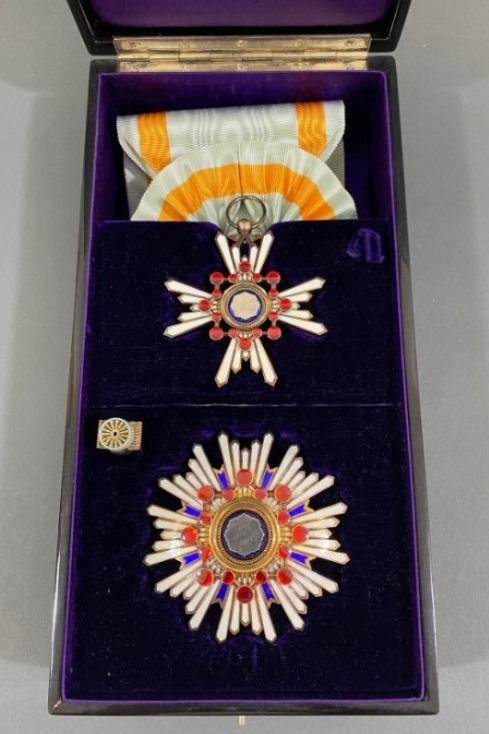
(1).thumb.jpg.38cff8cd9c5d55311a4208b0a83448ba.jpg)
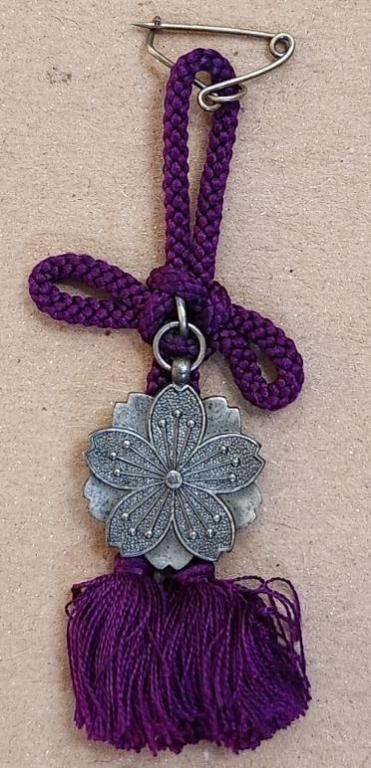
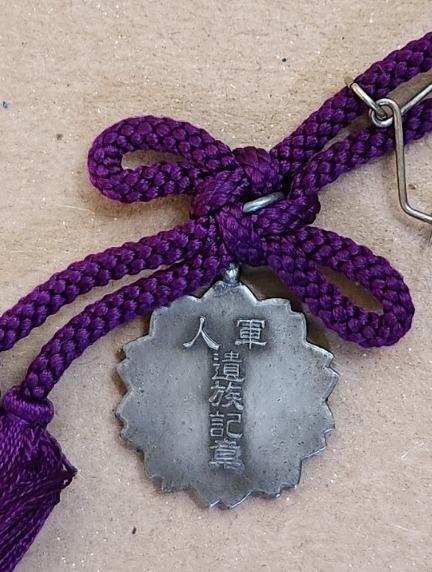
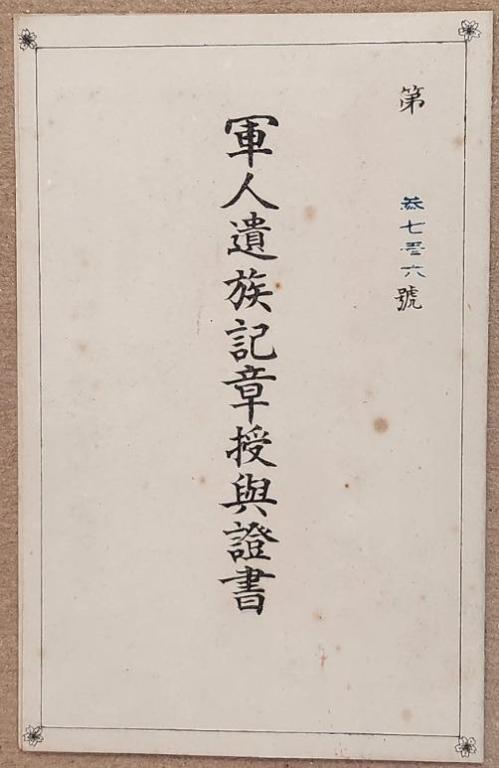
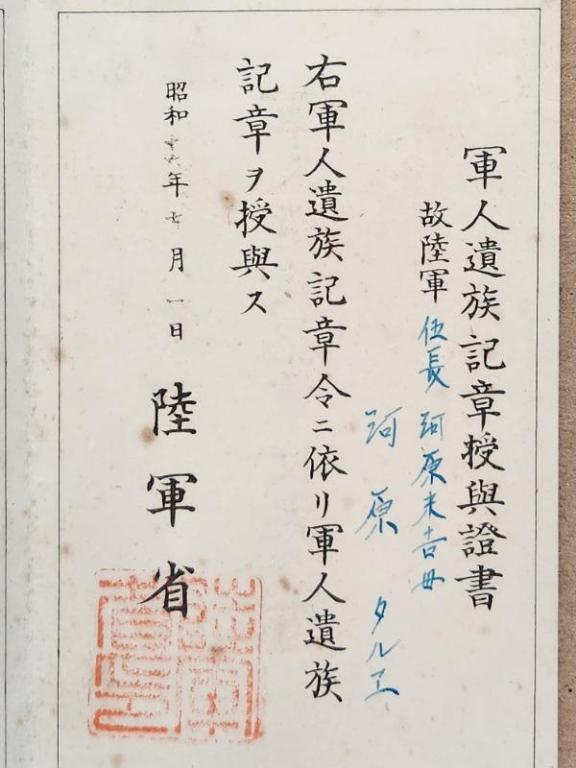
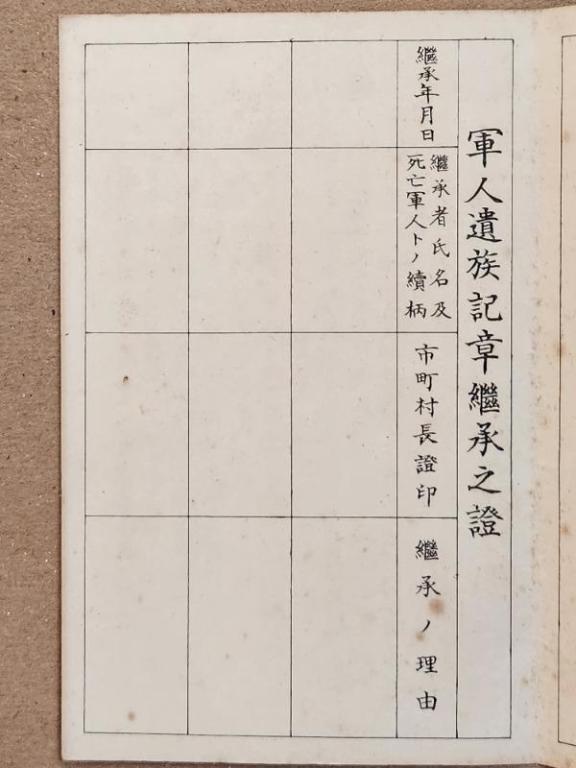
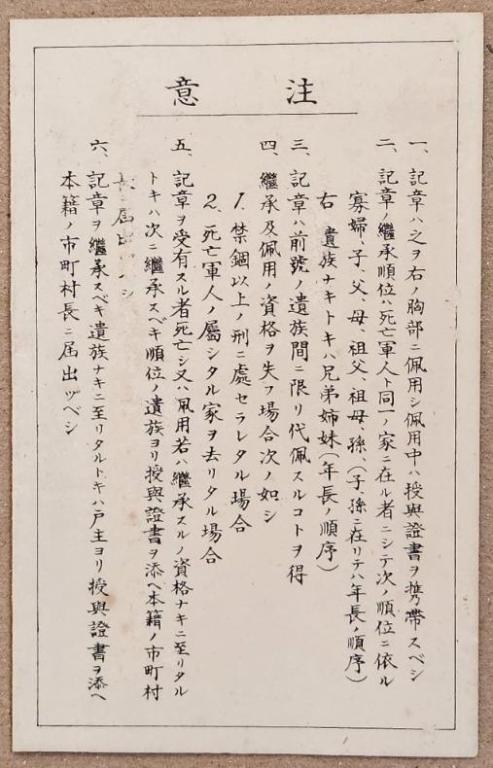
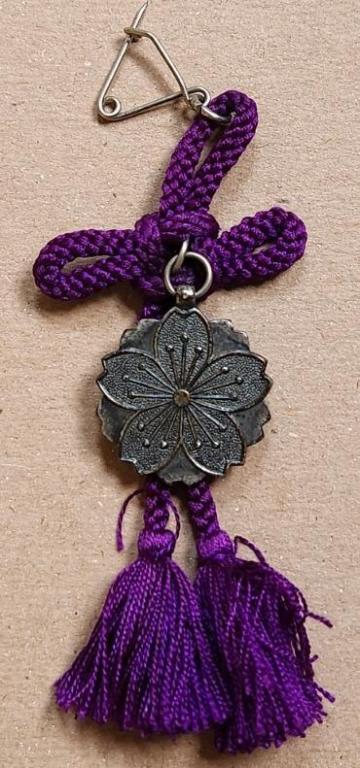

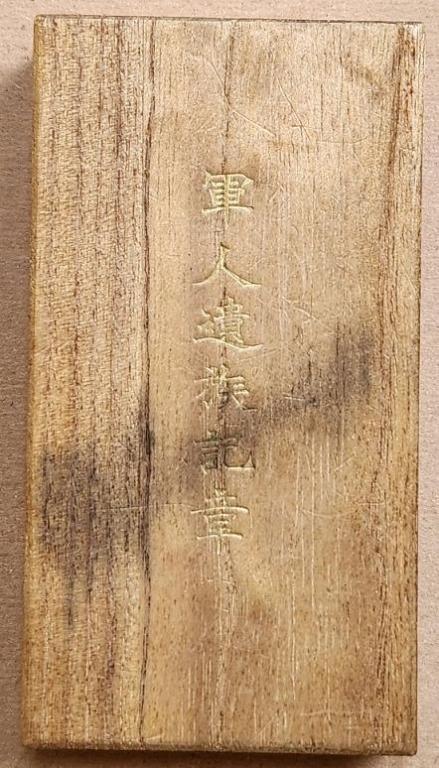
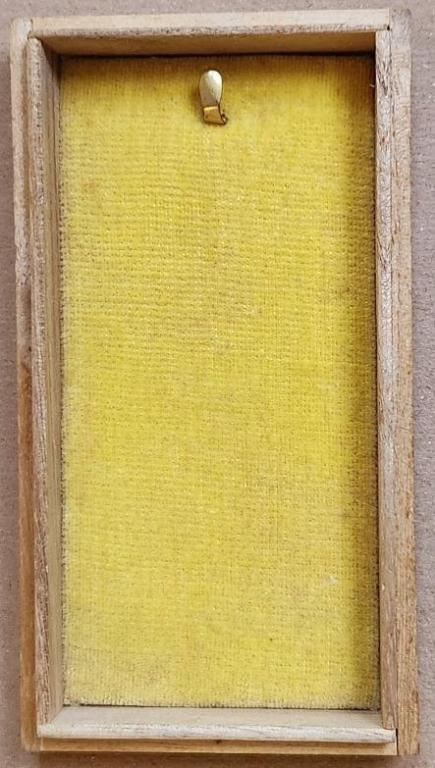
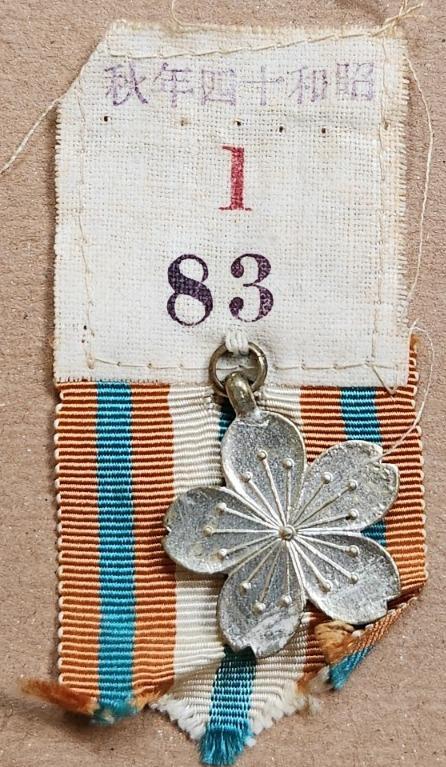
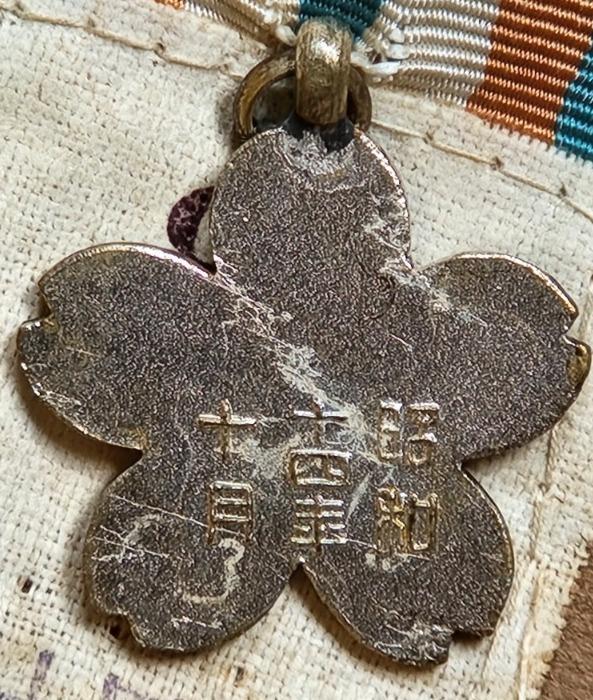
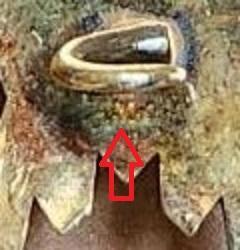
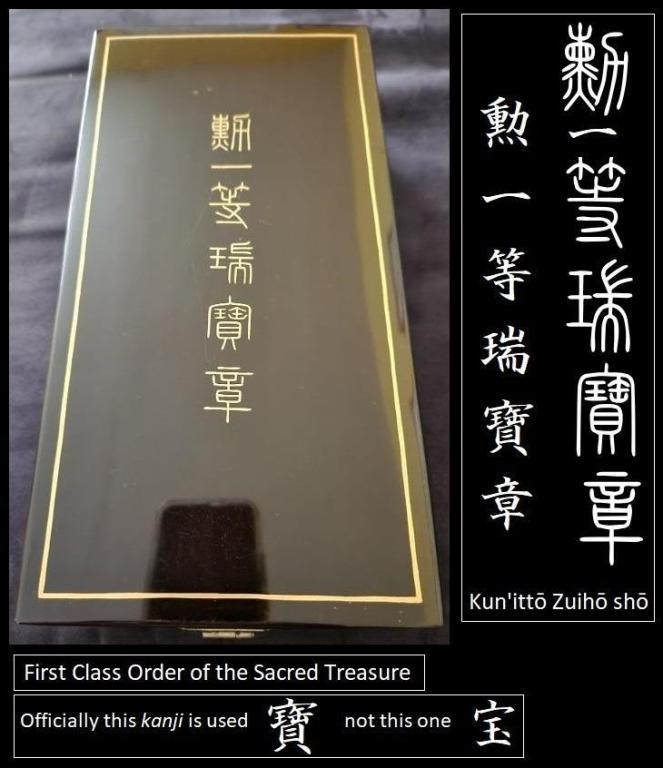
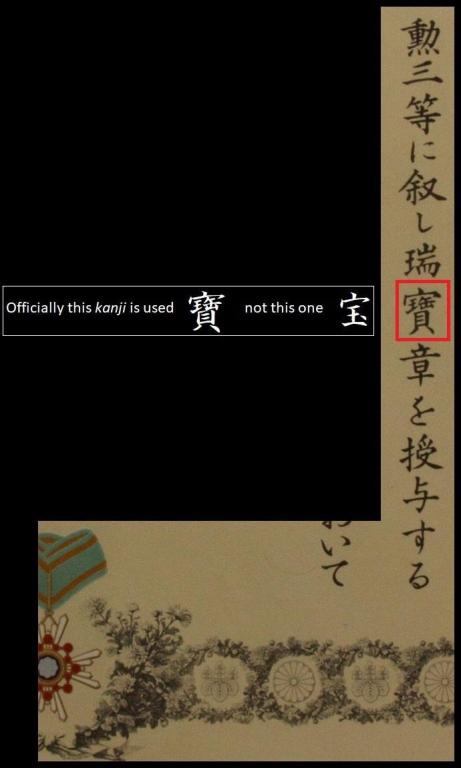
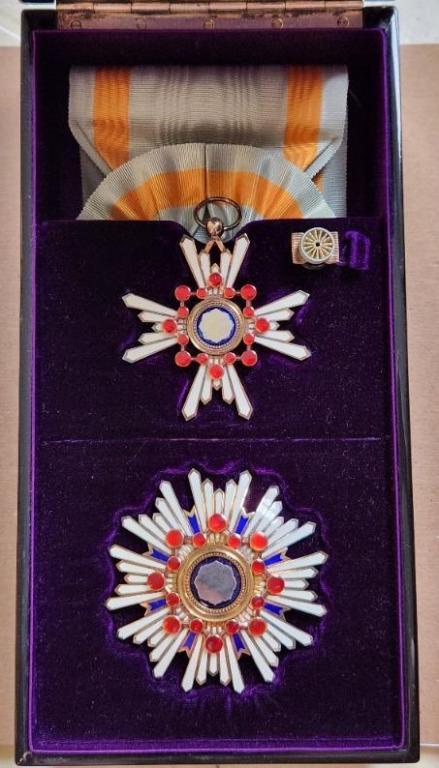
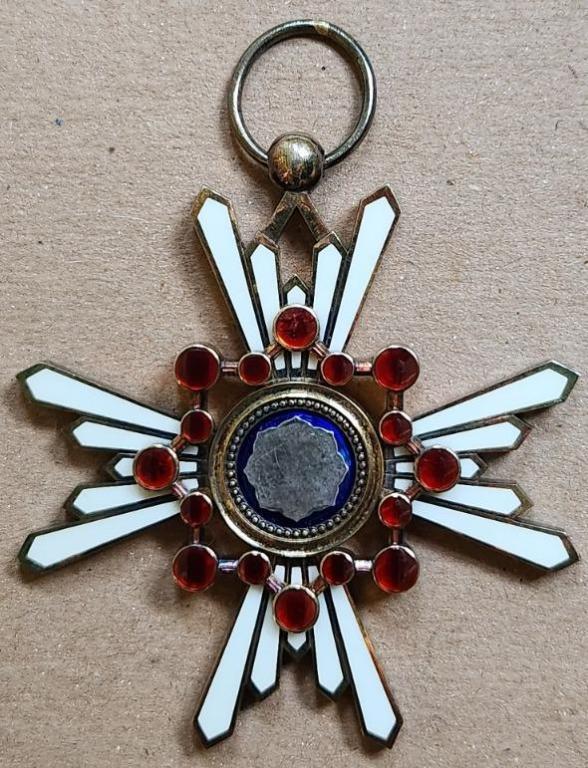
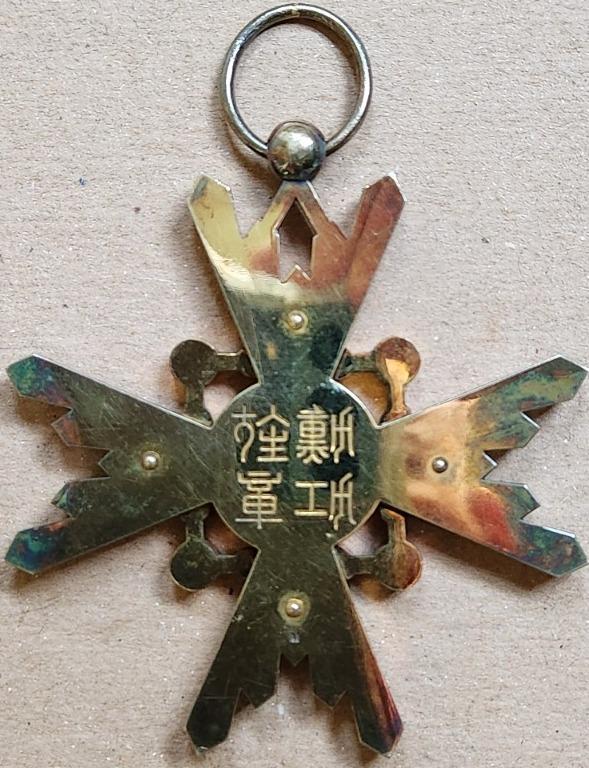
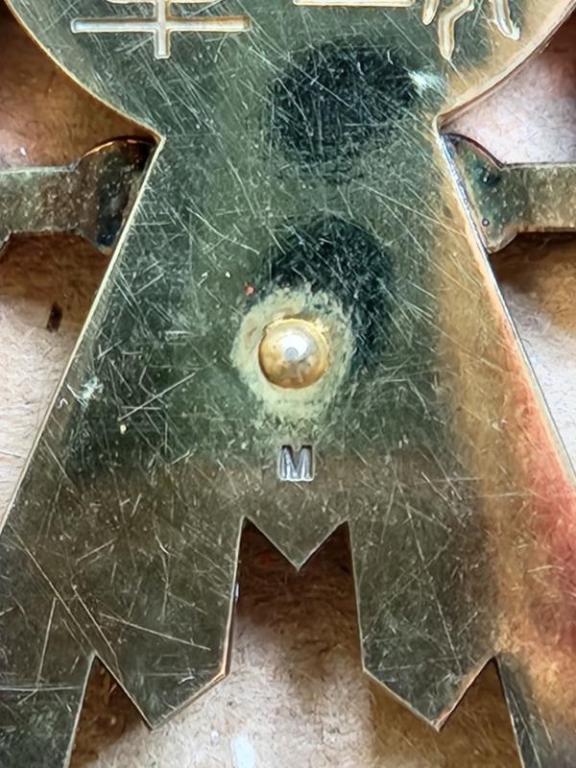
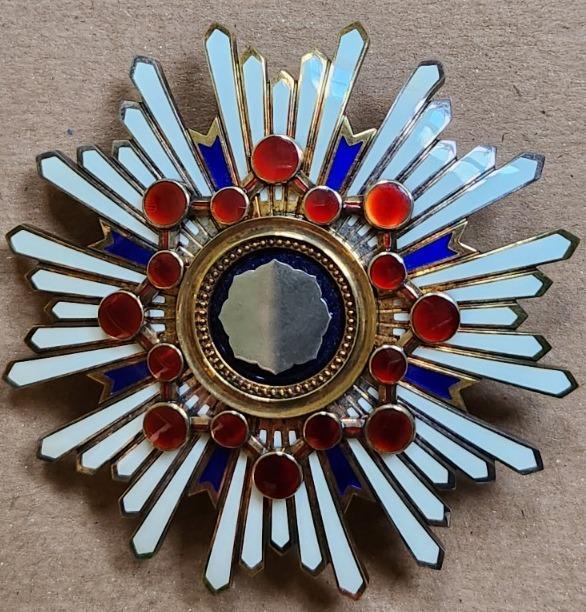
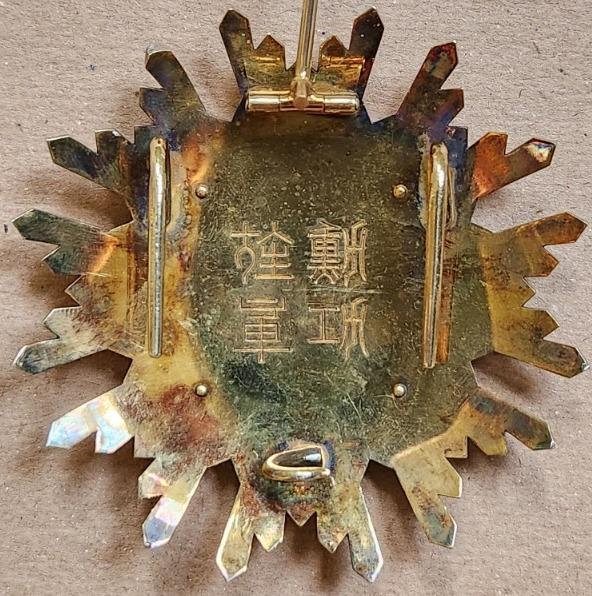

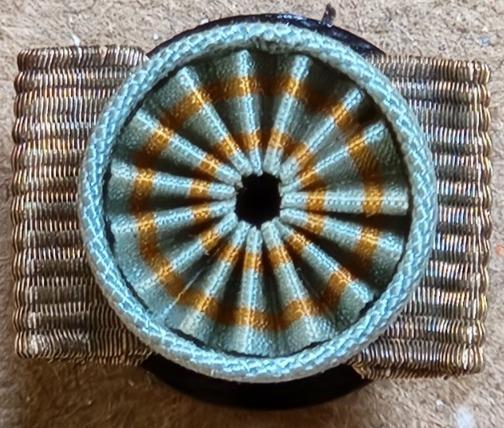
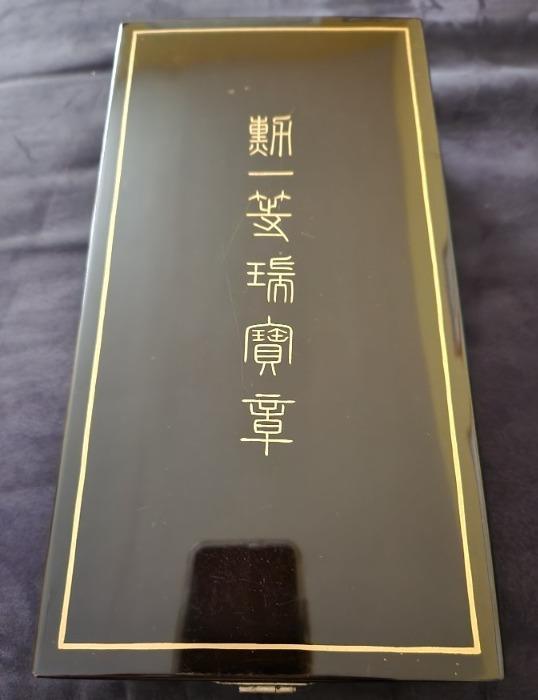
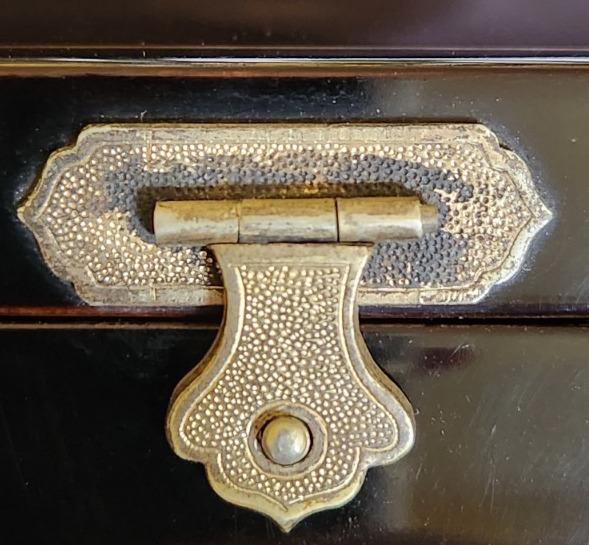
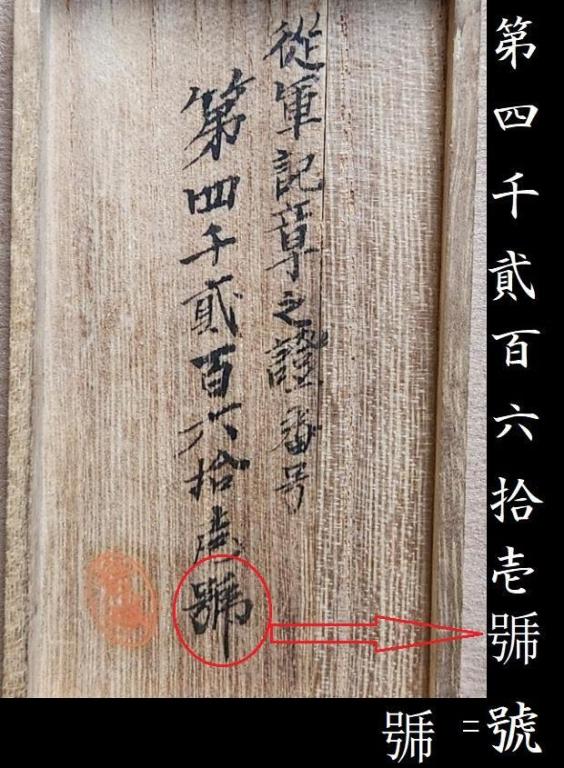
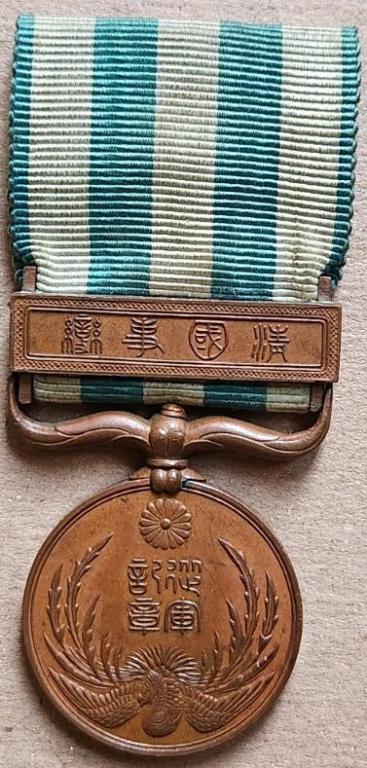
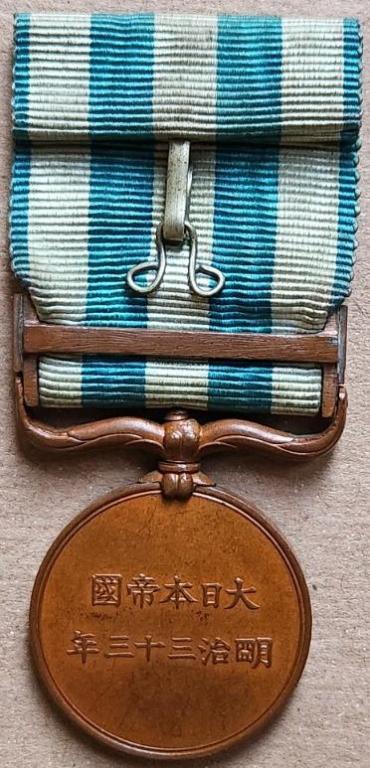
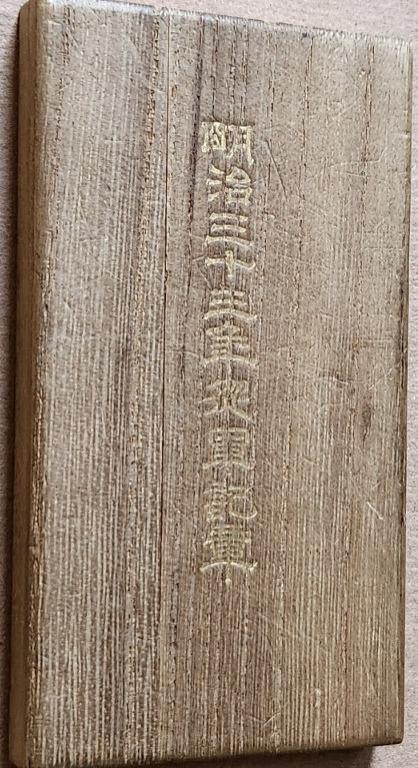
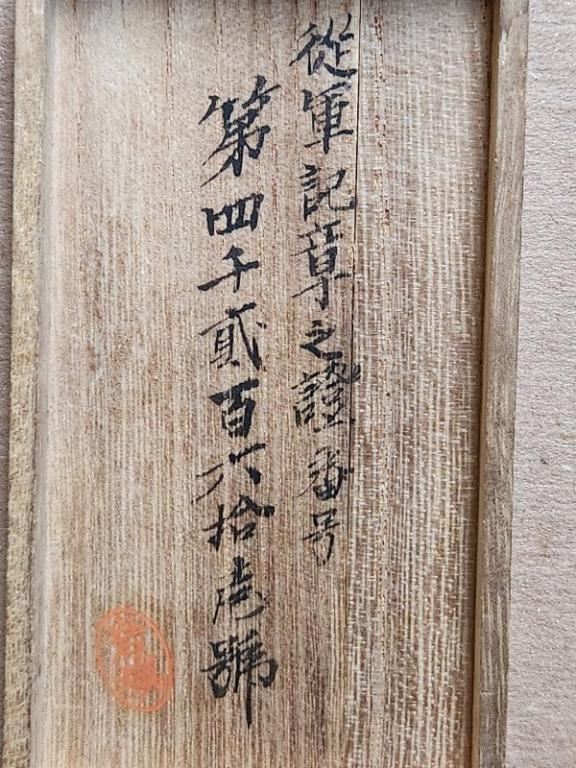



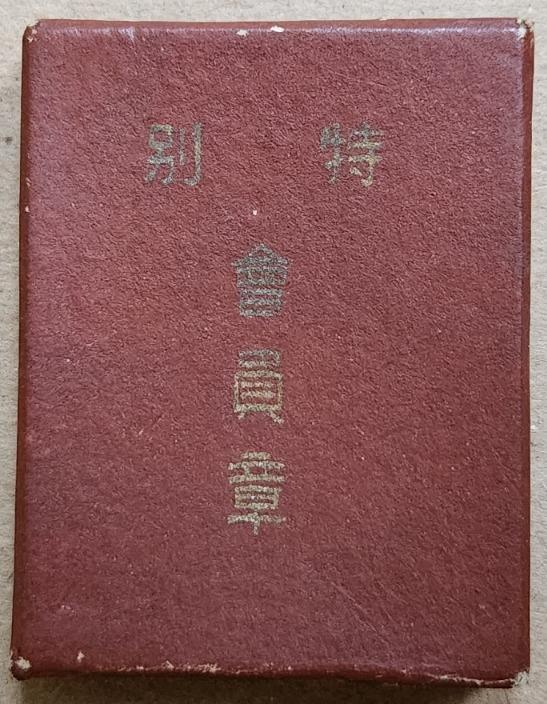
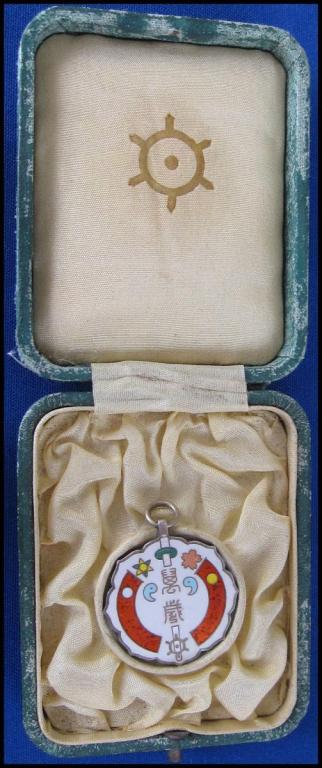
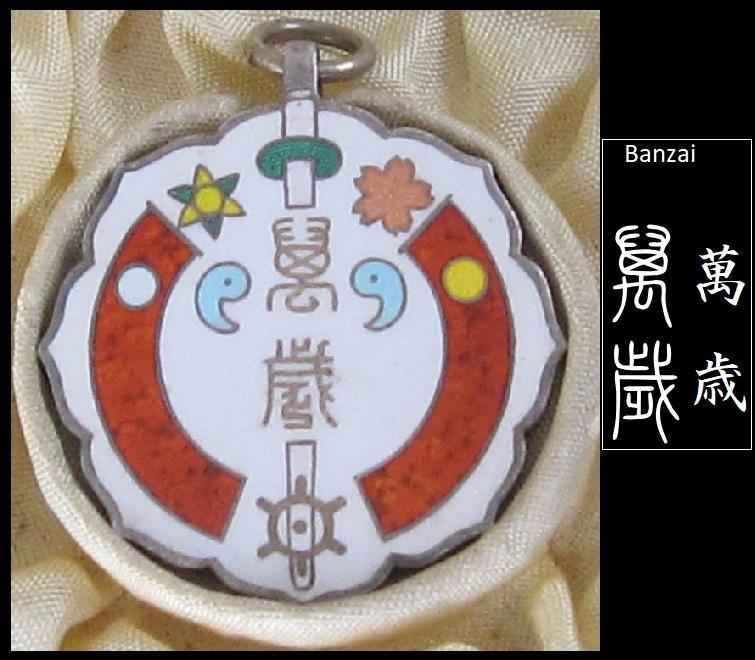

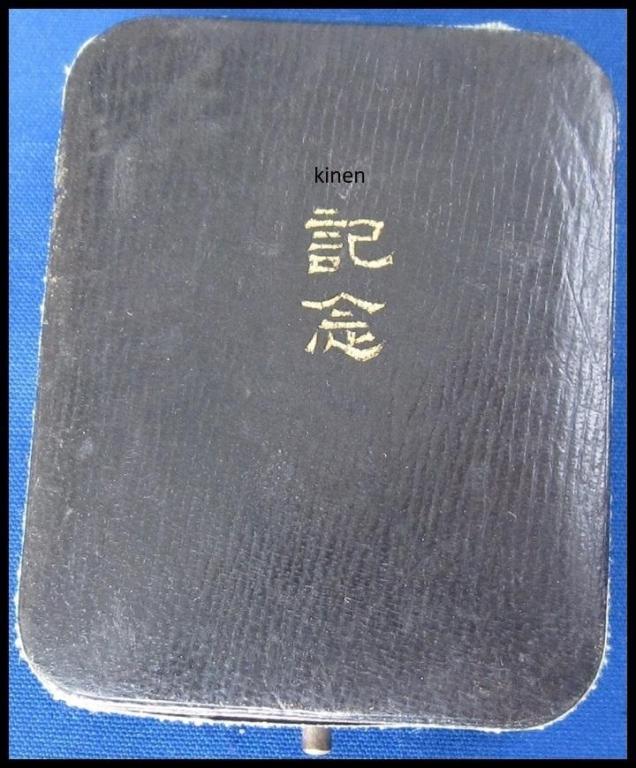
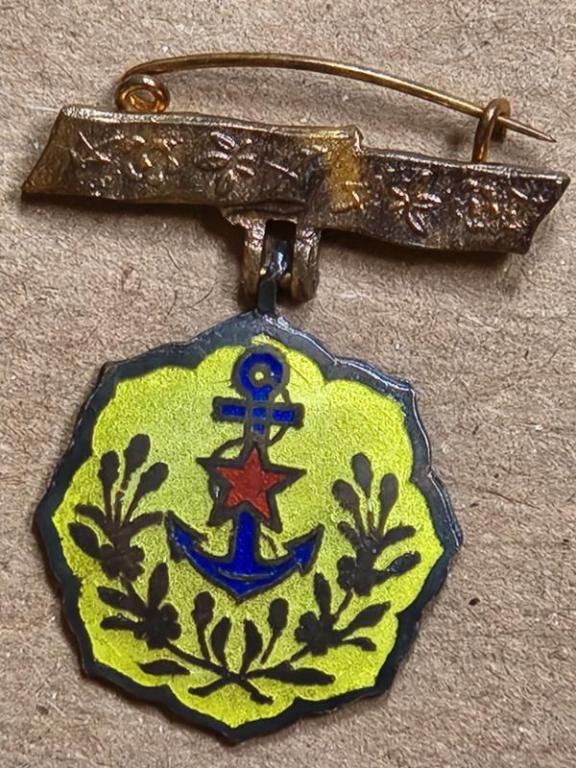
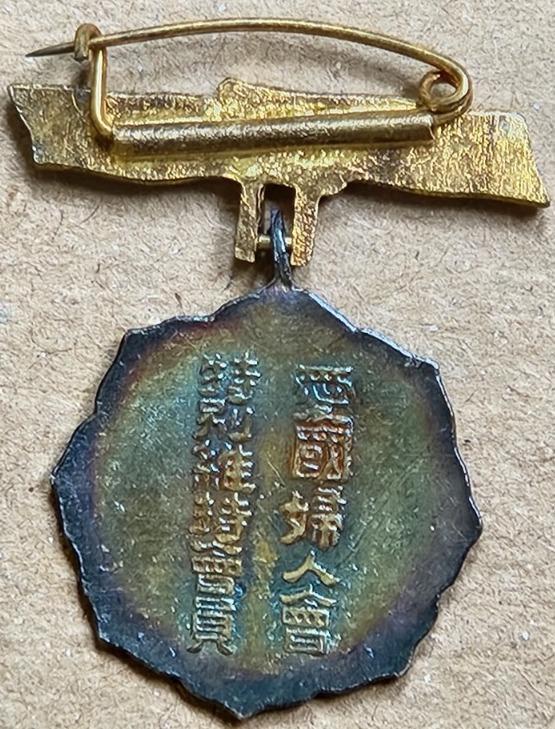

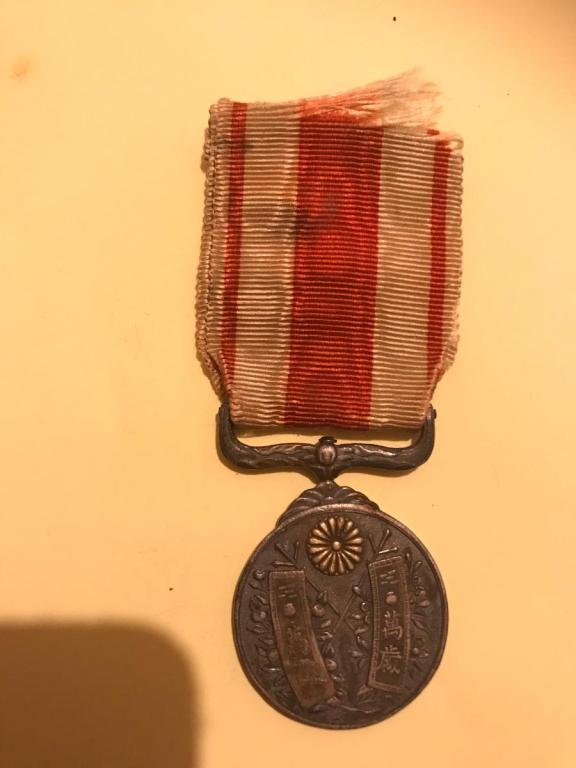
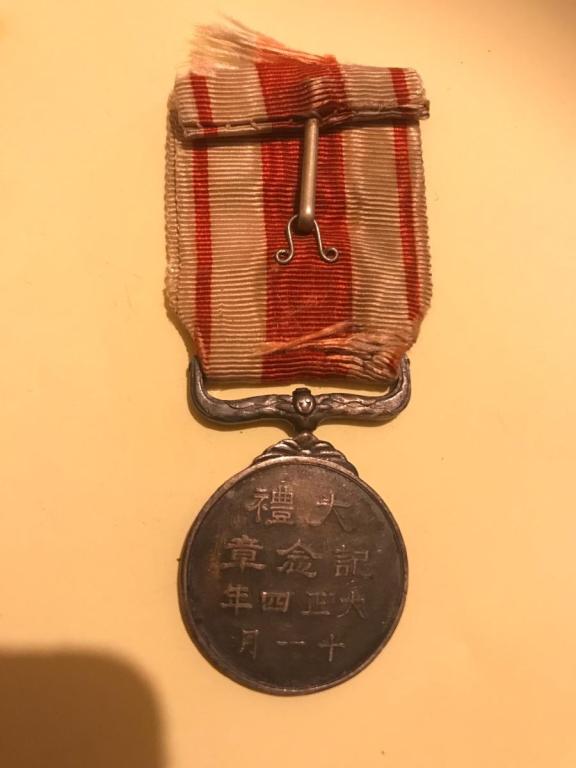
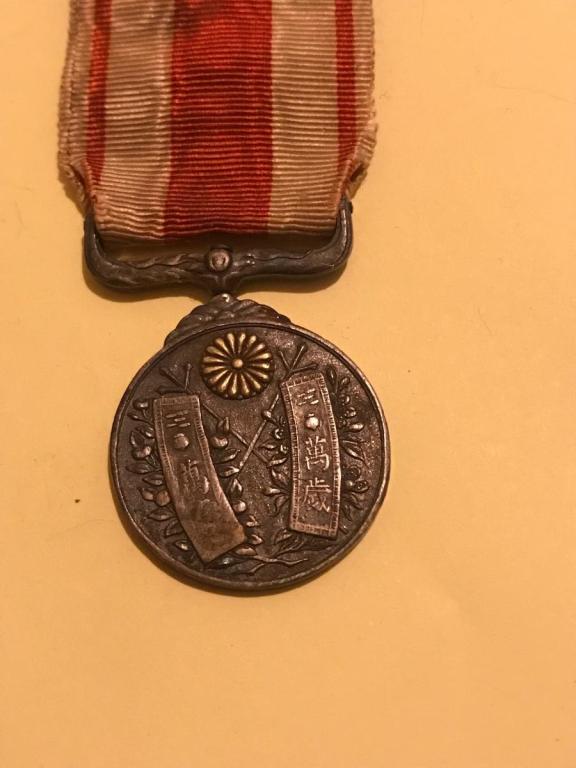
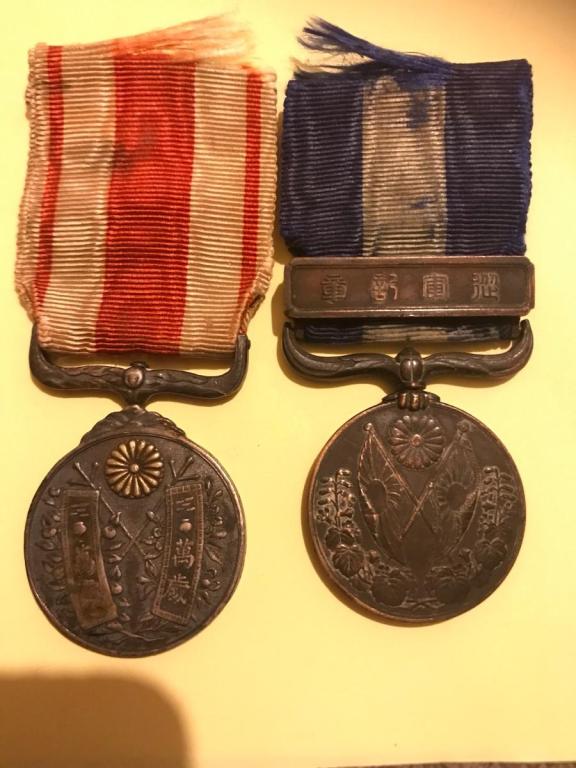

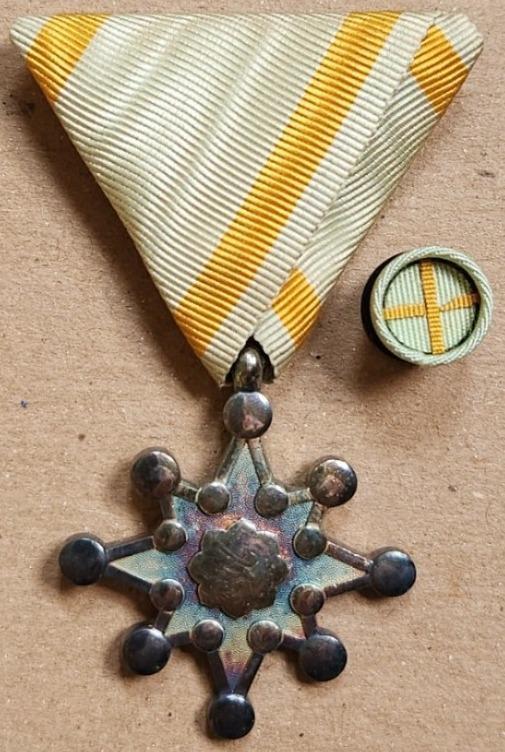
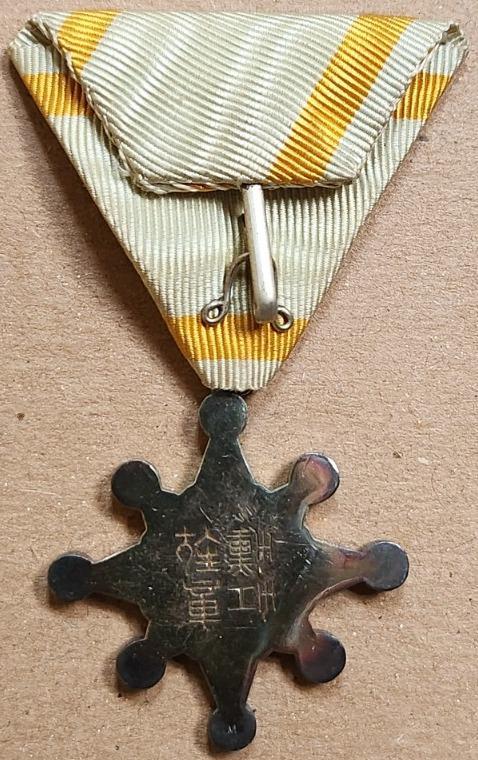
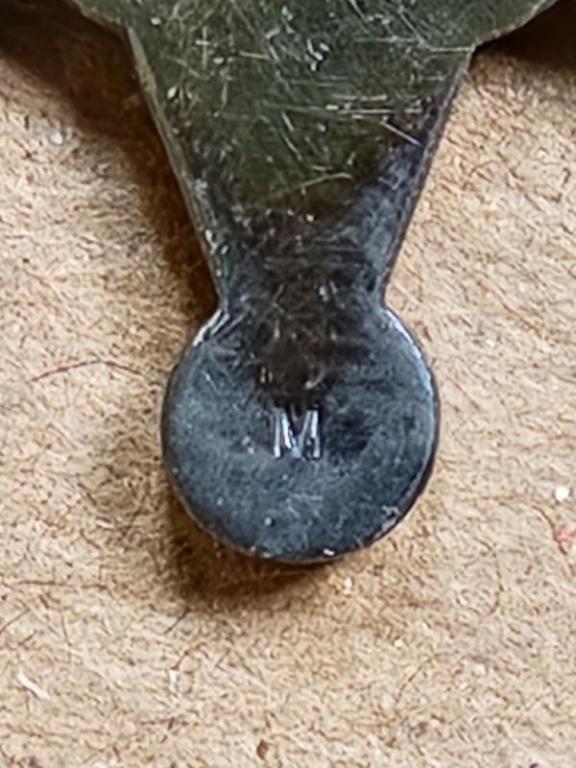
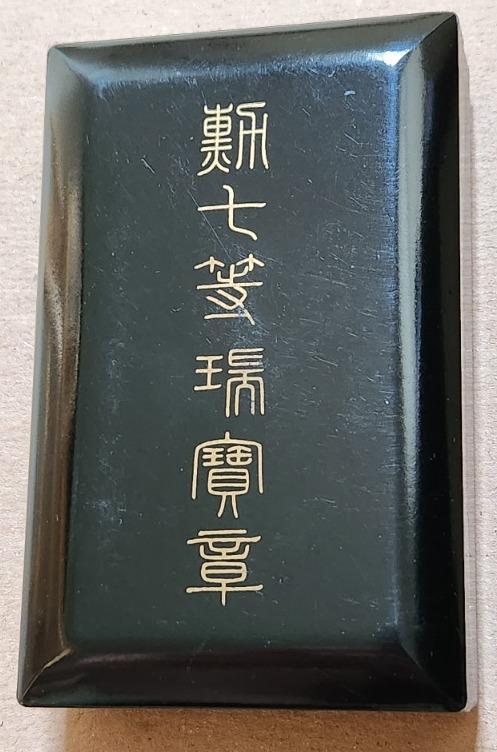


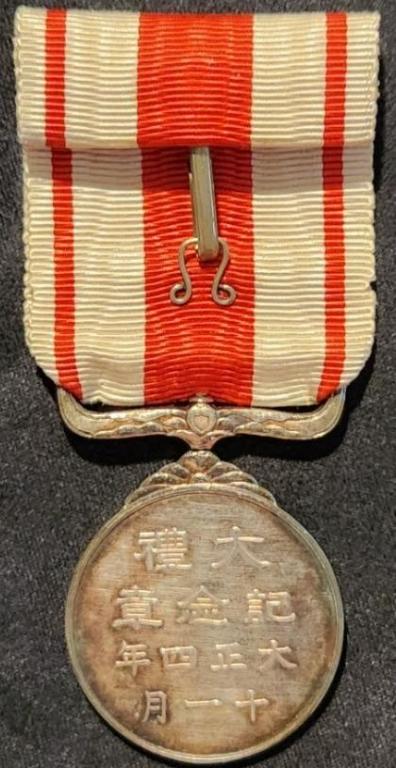
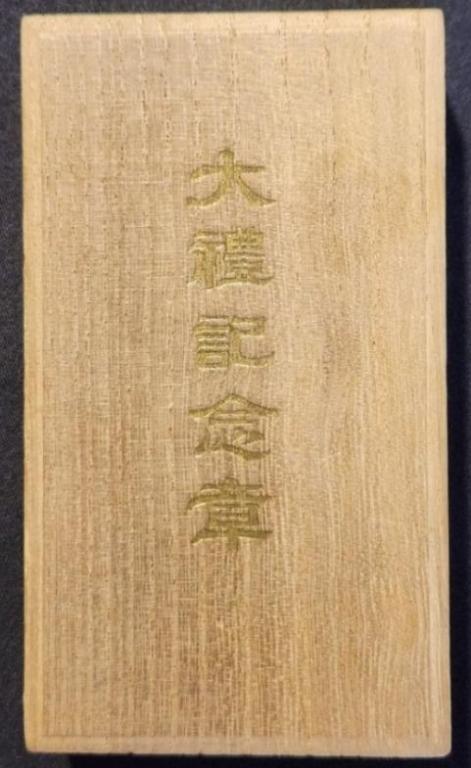

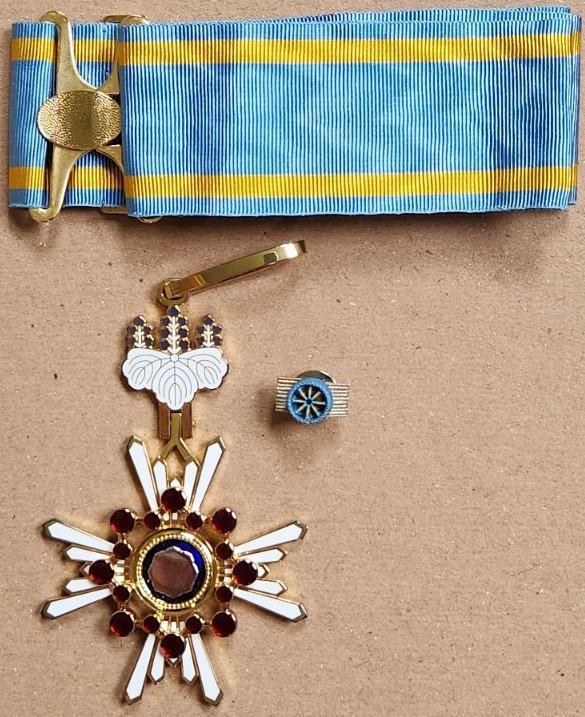

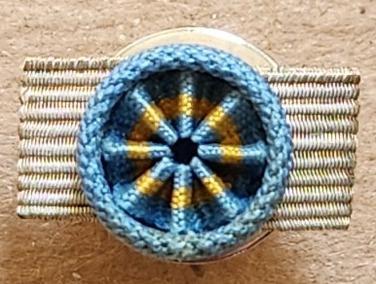
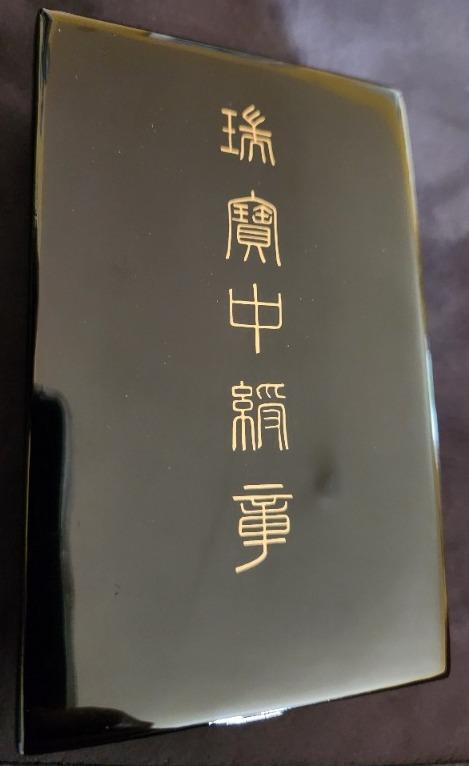

KIA and Yasukuni Shrine Soldier Enshrinement Badges
in Japan
Posted
No One,
Ahhh, thank you. On and off all day I thought about how to make the translation smooth or smoother in English using the word "inherit". "Conferment" does the trick.
Thank you again for helping me to make my documentation as complete and accurate as possible.
All the best,
Tracy